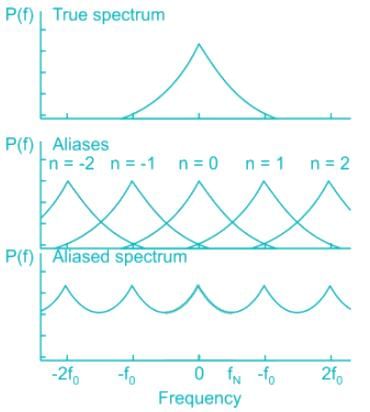Electronics and Communication Engineering (ECE) Exam > Electronics and Communication Engineering (ECE) Questions > If a 100 Hz sinusoidal signal is sampled at t...
Start Learning for Free
If a 100 Hz sinusoidal signal is sampled at the rates of 140 Hz, 90 Hz, and 30 Hz, then the aliased frequencies correspond to each sampling rate will be respectively:
- a)180 Hz, 40 Hz, 50 Hz
- b)30 Hz, 60 Hz, 50 Hz
- c)40 Hz, 10 Hz, 70 Hz
- d)60 Hz, 80 Hz, 10 Hz
Correct answer is option 'C'. Can you explain this answer?
Most Upvoted Answer
If a 100 Hz sinusoidal signal is sampled at the rates of 140 Hz, 90 Hz...
Sampling Frequency and Nyquist Frequency
Sampling Frequency: Sampling frequency is the number of samples taken per second. It is denoted by Fs.
Nyquist Frequency: Nyquist frequency is half of the sampling frequency. It is denoted by Fn = Fs / 2.
Aliasing and Aliased Frequencies
Aliasing: Aliasing is the phenomenon where a signal at a certain frequency appears to be at a different frequency due to undersampling.
Aliased Frequencies: Aliased frequencies are the frequencies at which a signal appears due to undersampling. They are given by the formula:
f_alias = f_signal - k * Fs
where k is an integer.
Solution
Given, the signal frequency is 100 Hz.
Sampling at 140 Hz:
Fn = 140 / 2 = 70 Hz
f_alias = 100 - k * 140 = 100 - 1 * 140 = -40 Hz (negative frequency is same as 140 - 40 = 100 Hz)
Therefore, the aliased frequency is 40 Hz.
Sampling at 90 Hz:
Fn = 90 / 2 = 45 Hz
f_alias = 100 - k * 90 = 100 - 1 * 90 = 10 Hz
Therefore, the aliased frequency is 10 Hz.
Sampling at 30 Hz:
Fn = 30 / 2 = 15 Hz
f_alias = 100 - k * 30 = 100 - 3 * 30 = 10 Hz
Therefore, the aliased frequency is 10 Hz.
Hence, the aliased frequencies correspond to each sampling rate will be 40 Hz, 10 Hz, and 10 Hz respectively. Therefore, option C is the correct answer.
Sampling Frequency: Sampling frequency is the number of samples taken per second. It is denoted by Fs.
Nyquist Frequency: Nyquist frequency is half of the sampling frequency. It is denoted by Fn = Fs / 2.
Aliasing and Aliased Frequencies
Aliasing: Aliasing is the phenomenon where a signal at a certain frequency appears to be at a different frequency due to undersampling.
Aliased Frequencies: Aliased frequencies are the frequencies at which a signal appears due to undersampling. They are given by the formula:
f_alias = f_signal - k * Fs
where k is an integer.
Solution
Given, the signal frequency is 100 Hz.
Sampling at 140 Hz:
Fn = 140 / 2 = 70 Hz
f_alias = 100 - k * 140 = 100 - 1 * 140 = -40 Hz (negative frequency is same as 140 - 40 = 100 Hz)
Therefore, the aliased frequency is 40 Hz.
Sampling at 90 Hz:
Fn = 90 / 2 = 45 Hz
f_alias = 100 - k * 90 = 100 - 1 * 90 = 10 Hz
Therefore, the aliased frequency is 10 Hz.
Sampling at 30 Hz:
Fn = 30 / 2 = 15 Hz
f_alias = 100 - k * 30 = 100 - 3 * 30 = 10 Hz
Therefore, the aliased frequency is 10 Hz.
Hence, the aliased frequencies correspond to each sampling rate will be 40 Hz, 10 Hz, and 10 Hz respectively. Therefore, option C is the correct answer.
Free Test
FREE
| Start Free Test |
Community Answer
If a 100 Hz sinusoidal signal is sampled at the rates of 140 Hz, 90 Hz...
Concept:
Aliased frequency component is given by:
fa = |fs – fm|
fs = sampling frequency
fm = message signal frequency
Aliased frequency component is given by:
fa = |fs – fm|
fs = sampling frequency
fm = message signal frequency
Calculation:
For a sampling rate of 140 Hz, since fs > fm:
Aliased Frequency = fs - fm,
= 140 – 100 = 40 Hz
For a sampling rate of 90 Hz, since fs < fm:
Aliased Frequency = fm – fs,
= 100 – 90 = 10 Hz
For a sampling rate of 30 Hz, since fs < fm:
Aliased Frequency = fm – fs
= 100 – 30 = 70 Hz
For a sampling rate of 140 Hz, since fs > fm:
Aliased Frequency = fs - fm,
= 140 – 100 = 40 Hz
For a sampling rate of 90 Hz, since fs < fm:
Aliased Frequency = fm – fs,
= 100 – 90 = 10 Hz
For a sampling rate of 30 Hz, since fs < fm:
Aliased Frequency = fm – fs
= 100 – 30 = 70 Hz
Aliasing is explained with the help of the spectrum as shown:



|
Explore Courses for Electronics and Communication Engineering (ECE) exam
|

|
Question Description
If a 100 Hz sinusoidal signal is sampled at the rates of 140 Hz, 90 Hz, and 30 Hz, then the aliased frequencies correspond to each sampling rate will be respectively:a)180 Hz, 40 Hz, 50 Hzb)30 Hz, 60 Hz, 50 Hzc)40 Hz, 10 Hz, 70 Hzd)60 Hz, 80 Hz, 10 HzCorrect answer is option 'C'. Can you explain this answer? for Electronics and Communication Engineering (ECE) 2025 is part of Electronics and Communication Engineering (ECE) preparation. The Question and answers have been prepared according to the Electronics and Communication Engineering (ECE) exam syllabus. Information about If a 100 Hz sinusoidal signal is sampled at the rates of 140 Hz, 90 Hz, and 30 Hz, then the aliased frequencies correspond to each sampling rate will be respectively:a)180 Hz, 40 Hz, 50 Hzb)30 Hz, 60 Hz, 50 Hzc)40 Hz, 10 Hz, 70 Hzd)60 Hz, 80 Hz, 10 HzCorrect answer is option 'C'. Can you explain this answer? covers all topics & solutions for Electronics and Communication Engineering (ECE) 2025 Exam. Find important definitions, questions, meanings, examples, exercises and tests below for If a 100 Hz sinusoidal signal is sampled at the rates of 140 Hz, 90 Hz, and 30 Hz, then the aliased frequencies correspond to each sampling rate will be respectively:a)180 Hz, 40 Hz, 50 Hzb)30 Hz, 60 Hz, 50 Hzc)40 Hz, 10 Hz, 70 Hzd)60 Hz, 80 Hz, 10 HzCorrect answer is option 'C'. Can you explain this answer?.
If a 100 Hz sinusoidal signal is sampled at the rates of 140 Hz, 90 Hz, and 30 Hz, then the aliased frequencies correspond to each sampling rate will be respectively:a)180 Hz, 40 Hz, 50 Hzb)30 Hz, 60 Hz, 50 Hzc)40 Hz, 10 Hz, 70 Hzd)60 Hz, 80 Hz, 10 HzCorrect answer is option 'C'. Can you explain this answer? for Electronics and Communication Engineering (ECE) 2025 is part of Electronics and Communication Engineering (ECE) preparation. The Question and answers have been prepared according to the Electronics and Communication Engineering (ECE) exam syllabus. Information about If a 100 Hz sinusoidal signal is sampled at the rates of 140 Hz, 90 Hz, and 30 Hz, then the aliased frequencies correspond to each sampling rate will be respectively:a)180 Hz, 40 Hz, 50 Hzb)30 Hz, 60 Hz, 50 Hzc)40 Hz, 10 Hz, 70 Hzd)60 Hz, 80 Hz, 10 HzCorrect answer is option 'C'. Can you explain this answer? covers all topics & solutions for Electronics and Communication Engineering (ECE) 2025 Exam. Find important definitions, questions, meanings, examples, exercises and tests below for If a 100 Hz sinusoidal signal is sampled at the rates of 140 Hz, 90 Hz, and 30 Hz, then the aliased frequencies correspond to each sampling rate will be respectively:a)180 Hz, 40 Hz, 50 Hzb)30 Hz, 60 Hz, 50 Hzc)40 Hz, 10 Hz, 70 Hzd)60 Hz, 80 Hz, 10 HzCorrect answer is option 'C'. Can you explain this answer?.
Solutions for If a 100 Hz sinusoidal signal is sampled at the rates of 140 Hz, 90 Hz, and 30 Hz, then the aliased frequencies correspond to each sampling rate will be respectively:a)180 Hz, 40 Hz, 50 Hzb)30 Hz, 60 Hz, 50 Hzc)40 Hz, 10 Hz, 70 Hzd)60 Hz, 80 Hz, 10 HzCorrect answer is option 'C'. Can you explain this answer? in English & in Hindi are available as part of our courses for Electronics and Communication Engineering (ECE).
Download more important topics, notes, lectures and mock test series for Electronics and Communication Engineering (ECE) Exam by signing up for free.
Here you can find the meaning of If a 100 Hz sinusoidal signal is sampled at the rates of 140 Hz, 90 Hz, and 30 Hz, then the aliased frequencies correspond to each sampling rate will be respectively:a)180 Hz, 40 Hz, 50 Hzb)30 Hz, 60 Hz, 50 Hzc)40 Hz, 10 Hz, 70 Hzd)60 Hz, 80 Hz, 10 HzCorrect answer is option 'C'. Can you explain this answer? defined & explained in the simplest way possible. Besides giving the explanation of
If a 100 Hz sinusoidal signal is sampled at the rates of 140 Hz, 90 Hz, and 30 Hz, then the aliased frequencies correspond to each sampling rate will be respectively:a)180 Hz, 40 Hz, 50 Hzb)30 Hz, 60 Hz, 50 Hzc)40 Hz, 10 Hz, 70 Hzd)60 Hz, 80 Hz, 10 HzCorrect answer is option 'C'. Can you explain this answer?, a detailed solution for If a 100 Hz sinusoidal signal is sampled at the rates of 140 Hz, 90 Hz, and 30 Hz, then the aliased frequencies correspond to each sampling rate will be respectively:a)180 Hz, 40 Hz, 50 Hzb)30 Hz, 60 Hz, 50 Hzc)40 Hz, 10 Hz, 70 Hzd)60 Hz, 80 Hz, 10 HzCorrect answer is option 'C'. Can you explain this answer? has been provided alongside types of If a 100 Hz sinusoidal signal is sampled at the rates of 140 Hz, 90 Hz, and 30 Hz, then the aliased frequencies correspond to each sampling rate will be respectively:a)180 Hz, 40 Hz, 50 Hzb)30 Hz, 60 Hz, 50 Hzc)40 Hz, 10 Hz, 70 Hzd)60 Hz, 80 Hz, 10 HzCorrect answer is option 'C'. Can you explain this answer? theory, EduRev gives you an
ample number of questions to practice If a 100 Hz sinusoidal signal is sampled at the rates of 140 Hz, 90 Hz, and 30 Hz, then the aliased frequencies correspond to each sampling rate will be respectively:a)180 Hz, 40 Hz, 50 Hzb)30 Hz, 60 Hz, 50 Hzc)40 Hz, 10 Hz, 70 Hzd)60 Hz, 80 Hz, 10 HzCorrect answer is option 'C'. Can you explain this answer? tests, examples and also practice Electronics and Communication Engineering (ECE) tests.

|
Explore Courses for Electronics and Communication Engineering (ECE) exam
|

|
Signup for Free!
Signup to see your scores go up within 7 days! Learn & Practice with 1000+ FREE Notes, Videos & Tests.


















